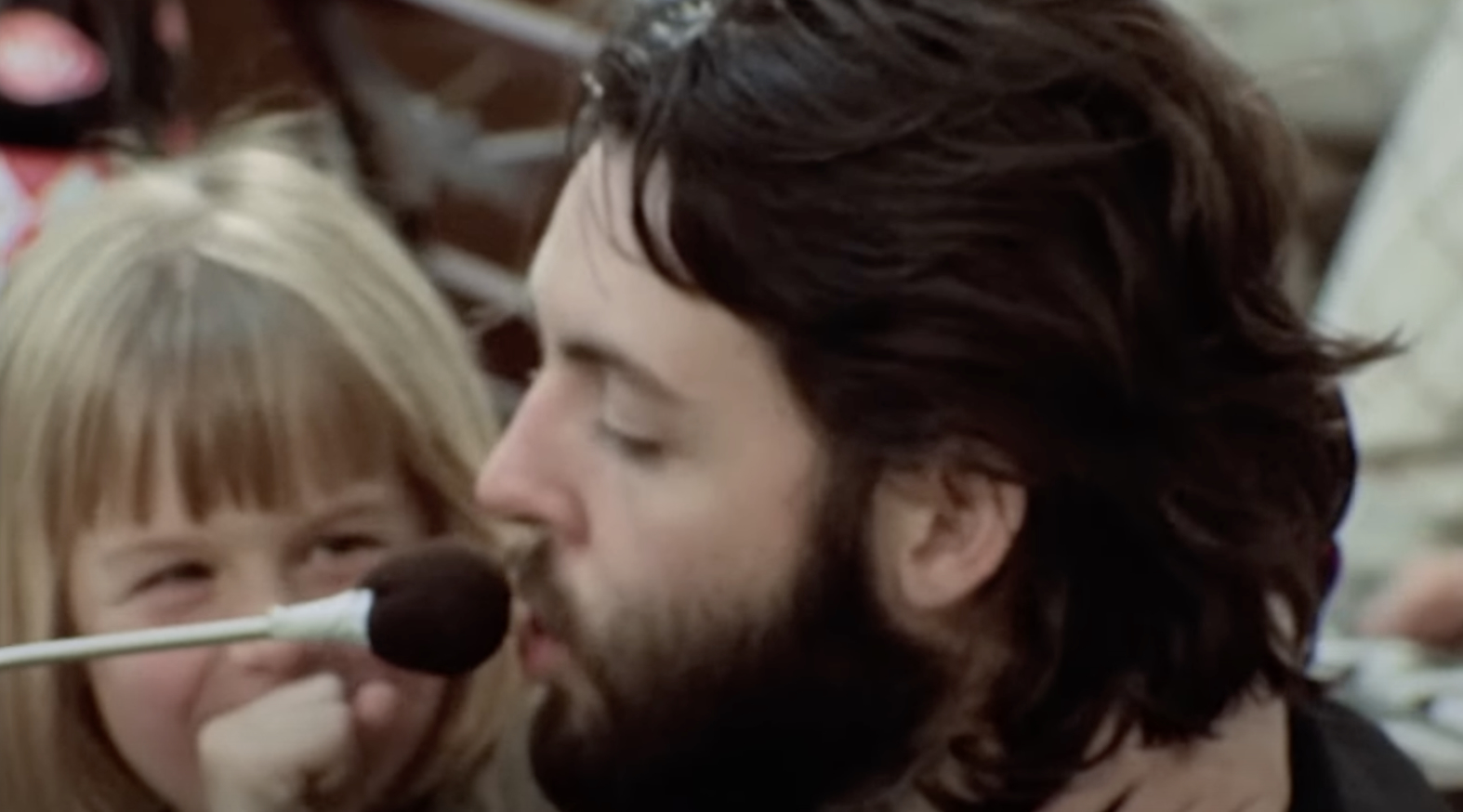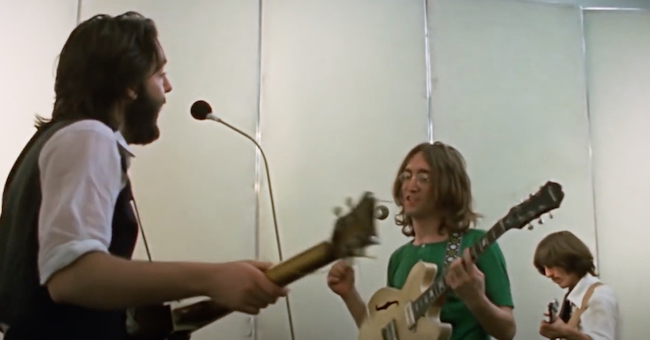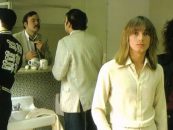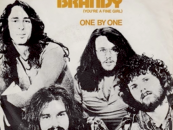The Beatles Restored ‘Let It Be’ Film Shows a Band Still at a Creative Peak: Review
by Greg Brodsky
The Beatles: Let it Be, exclusively on Disney+. © 2024 Apple Films Ltd.
Let It Be, director Michael Lindsay-Hogg’s original 1970 film about The Beatles, has been magnificently restored by Peter Jackson and his Park Road Production team that delivered 2021’s Emmy Award®-winning docuseries, The Beatles: Get Back. The revelatory new version launched exclusively on Disney+ on May 8, 2024. The film was screened for an invitation-only audience at the AMC Lincoln Square in New York City on April 29, preceded by a Q-and-A with the director—who turned 84 on May 5—along with longtime Apple Corps Ltd. exec Jonathan Clyde.
[On May 10, The Beatles released a new music video for the song “Let It Be” featuring clips from the restored film, along with unseen outtakes from the rushes. Watch it at the end of this story.]
Lindsay-Hogg had already collaborated with The Beatles many times, creating short films for many of their songs, including “Paperback Writer” and “Revolution,” in the pre-video days. In 1968, he filmed one for “Hey Jude,” in front of a studio audience. “During breaks,” he recalls, “they played for a crowd, the first time before a live audience since they stopped touring in 1966.” The band was enthusiastic about the idea of doing a concert and Lindsay-Hogg was hired, initially, to film their rehearsals while the concept and location for the concert were simultaneously being vetted. The original premise was “very different than what [Let It Be] turned out to be,” he recalls.
Paul McCartney wanted to bring in two cameras to film a trailer and the director knew he would be shooting the Beatles rehearsing. However, when the grand ideas for a concert, at potential locations near and far, were scuttled, Lindsay-Hogg’s assignment became to make a documentary, the third film in the band’s deal with United Artists.
When the film was first released, it received mixed reactions from critics and the public, and was always associated with what’s long been thought of as the Beatles’ “sour period” with regard to their personal relationships. Once viewed through a darker lens, the 2024 edition is now brought to light through its restoration and in the context of revelations brought forth in Jackson’s The Beatles: Get Back docuseries. Jackson’s team was able to unearth a lot more dialogue and bits of music than what was in the film’s original version.
It was Jackson who advocated for Let It Be to be reissued as a stand-alone film. Says Lindsay-Hogg, “Peter said, ‘I’m making a documentary about the making of a documentary.”
Its four stars show up at the studio each day wearing colorful outfits befitting the reputation of late ’60s London as the world’s fashion capitol for the young. Throughout, Lennon’s and McCartney’s personalities, in particular, are brought out in the studio setting.
The film treats viewers to dozens of performances as the four Beatles fine-tune material that they’ve been working on. We see how tracks from the 1970 Let It Be album evolved, such as John Lennon’s “Across the Universe” and McCartney’s “I’ve Got a Feeling” and “Two Of Us” (with Lennon able to sing backup and chew gum at the same time).
But we’re also witness to songs that would ultimately arrive first on 1969’s Abbey Road. There’s a tender moment where George Harrison plays piano while helping Ringo Starr develop “Octopus’s Garden.”
And there are plenty of sterling performances of future favorites including “Maxwell’s Silver Hammer” and “Oh! Darling.” While Harrison is performing his “I Me Mine,” Lennon and Yoko Ono are shown dancing during the song’s waltz portion.
Like so many bands in their early days, The Beatles performed plenty of covers in their live sets. Lindsay-Hogg captures their lively versions of such classics as “Bésame Mucho” and medleys of “Rip It Up”/”Shake, Rattle and Roll,” and “Kansas City”/”Lawdy Miss Clawdy.” When we see them perform Smokey Robinson’s “You’ve Really Got a Hold on Me,” it’s the first time the camera shows a famous fifth musician in the studio: keyboardist Billy Preston, incredibly just 22 at the time. It’s hard to imagine McCartney’s “Get Back” without him.
All the while, Lindsay-Hogg captures some of the Beatles’ well known entourage like personal assistant and jack-of-all-trades Mal Evans. (Legendary producer George Martin is rarely seen.) There’s Ono, generally seen simply observing the four Beatles making music. Six-year-old Heather McCartney, Linda’s daughter by her first marriage, adds some moments of levity; she’s right in the middle of things as the band works through Lennon’s “Dig It.”

Heather McCartney with Paul McCartney in Let It Be
Of the famous January 30, 1969, rooftop performance shot above the Apple offices in London, the director says, “I knew [the film] was going to run chronologically. I was looking for a conclusion to this episode of their lives.”
Those scenes are breathtaking for many reasons. Lindsay Hogg’s team anticipated that when Londoners heard the performance from the rooftop, it would essentially stop traffic as office workers and passersby spilled out onto the streets to try to see what was causing the commotion. The director’s crew catches their reactions, providing plenty of interviews, sometimes to comedic effect. Let It Be frequently cuts to the rooftop performance (with Preston), Beatles insiders viewing the proceedings, shots of people watching from other rooftops, and those marvelous street reactions.

“Those marvelous street reactions”when The Beatles were performing on the Apple rooftop
“Once they stopped touring,” Lindsay-Hogg says, “they lived different lives, taking different directions. But they loved each other. Ringo said, ‘Only the four of us will know what it was like.'”
[Deluxe editions of the Let It Be album are available in the U.S. here and in the U.K. here.]
From the Disney+ April 16 announcement: First released in May 1970 amidst the swirl of The Beatles’ breakup, Let It Be now takes its rightful place in the band’s history. Released on Disney+ in 2021, the docuseries showcases the iconic foursome’s warmth and camaraderie, capturing a pivotal moment in music history.
Let It Be contains footage not featured in the Get Back docuseries, bringing viewers into the studio and onto Apple Corps’ London rooftop in January 1969 as The Beatles, joined by Preston, write and record their GRAMMY Award®-winning album Let It Be, with its Academy Award®-winning title song, and perform live for the final time as a group. With the release of The Beatles: Get Back, fan clamor for the original Let It Be film reached a fever pitch. With Lindsay-Hogg’s full support, Apple Corps asked Peter Jackson’s Park Road Post Production to dive into a meticulous restoration of the film from the original 16mm negative, which included lovingly remastering sound using the same MAL de-mix technology that was applied to the Get Back docuseries.
In the reissue’s April 16 announcement, Lindsay-Hogg said, “Let It Be was ready to go in October/November 1969, but it didn’t come out until April 1970. One month before its release, The Beatles officially broke up. And so the people went to see Let It Be with sadness in their hearts, thinking, ‘I’ll never see The Beatles together again. I will never have that joy again,’ and it very much darkened the perception of the film. But, in fact, how often do you get to see artists of this stature working together to make what they hear in their heads into songs? And then you get to the roof, and you see their excitement, camaraderie and sheer joy in playing together again as a group and know, as we do now, that it was the final time, and we view it with the full understanding of who they were and still are and a little poignancy. I was knocked out by what Peter was able to do with Get Back, using all the footage I’d shot 50 years previously.”

A screen grab from The Beatles: Get Back
Lindsay-Hogg spoke about the original film in an interview published in The New York Times on April 16. He was asked about a scene in which McCartney and Harrison argue. “No one had ever seen the Beatles have a fight, but that wasn’t really a fight,” he said. “Up to that point, no one had filmed, except in bits and pieces, the Beatles rehearsing. So that was new territory. That exchange between Paul and George, they never commented on, because it was the same kind of conversation that any artistic collaborators would have. As a director in the theater and in movies, I know that kind of conversation happens five times a week.”
He went on. “It’s clear that you’re looking at four men who have known each other since they were teenagers — well, three of them anyway — who love each other as brothers might. But they weren’t anymore the Fab Four, the mop-tops. A couple of them are pushing 30. They had stopped touring, which is a very big change for a rock ’n’ roll group. What you see in the movie is that the affection is eternal between the four of them. But they were living very separate lives now.”

A screenshot from The Beatles Let It Be
He was asked if at the time he filmed them whether he thought The Beatles were on the verge of breaking up. “No, not at all. We started shooting with four Beatles. We ended it with four Beatles. It was not like the San Andreas Fault. I thought they might go off and do their own thing, follow their heart and release separate albums, but then get together, because the Beatles were a very powerful artistic force, and also social force. I didn’t think the Beatles were going to break up till they broke up.”
Of its digital restoration, Lindsay-Hogg said, “The new version is a 21st century version of a 20th century movie. It is certainly brighter and livelier than what ended up on videotape. It looks now like it was intended to look in 1969 or 1970, although at my request, Peter did give it a more filmic look than Get Back, which had a slightly more modern and digital look.”
“I’m absolutely thrilled that Michael’s movie, Let It Be, has been restored and is finally being re-released after being unavailable for decades,” says Peter Jackson. “I was so lucky to have access to Michael’s outtakes for Get Back, and I’ve always thought that Let It Be is needed to complete the Get Back story. Over three parts, we showed Michael and The Beatles filming a groundbreaking new documentary, and Let It Be is that documentary – the movie they released in 1970. I now think of it all as one epic story, finally completed after five decades. The two projects support and enhance each other: Let It Be is the climax of Get Back, while Get Back provides a vital missing context for Let It Be. Michael Lindsay-Hogg was unfailingly helpful and gracious while I made Get Back, and it’s only right that his original movie has the last word…looking and sounding far better than it did in 1970.”
Let It Be was not originally received well. The restored version should change many opinions. The last thing a gratified Lindsay-Hogg said at the April 29 film screening was, “Life doesn’t always turn out the way you want it to. But every 50 years it does.”
Watch the 2024 music video for the song “Let It Be”
Let It Be, directed by Michael Lindsay-Hogg, stars John Lennon, Paul McCartney, George Harrison and Ringo Starr, with a special appearance by Billy Preston. The film was produced by Neil Aspinall with The Beatles acting as executive producers. The director of photography was Anthony B Richmond.






6 Comments so far
Jump into a conversationLet’s hope it will get a theatrical release as well.
I’m glad it’s been remastered, but I’m not so sure about the statement that it’s been unavailable for more than 50 years. I first saw it on HBO around 1979, and rented a VHS copy about a decade later. It may not have been in movie theaters, but it has certainly been available.
I’ve owned a VHS copy of Let It Be for decades. Harder to find a player now than the video.
Aside from a VHS, Betamax and laserdisc release in 1981 and a CED release the following year, LET IT BE has been unavailable for legit home viewing. A European release on VHS happened in the ’80’s, but the rest have all been bootlegs. The LET IT BE CED disc has been a highly sought collectable ever since it was released, but this should pretty much kill that off.
I always have liked this Beatles’ film. I’m glad it’s finally getting its official re-release. It will not top “Get Back” but it’s still a classic film.
in 2002, i got tired of the pissin and bitchen from them, then found a copy for sale in the back of a guitar player mag i subscribed to, and bot it for 20$! happy er’ since!